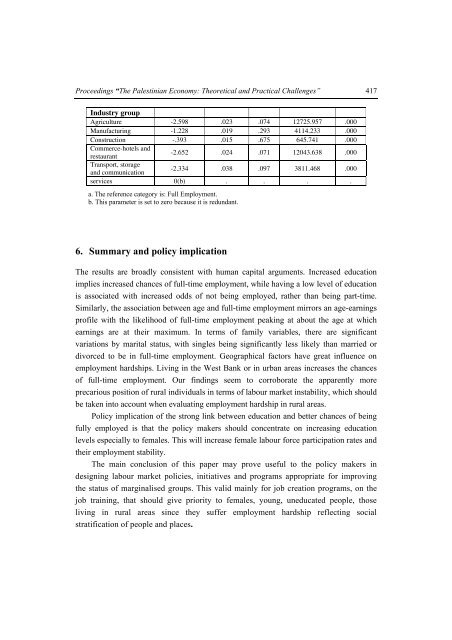The Palestinian Economy. Theoretical and Practical Challenges
The Palestinian Economy. Theoretical and Practical Challenges
The Palestinian Economy. Theoretical and Practical Challenges
You also want an ePaper? Increase the reach of your titles
YUMPU automatically turns print PDFs into web optimized ePapers that Google loves.
Proceedings “<strong>The</strong> <strong>Palestinian</strong> <strong>Economy</strong>: <strong>The</strong>oretical <strong>and</strong> <strong>Practical</strong> <strong>Challenges</strong>” 417<br />
Industry group<br />
Agriculture -2.598 .023 .074 12725.957 .000<br />
Manufacturing -1.228 .019 .293 4114.233 .000<br />
Construction -.393 .015 .675 645.741 .000<br />
Commerce-hotels <strong>and</strong><br />
restaurant<br />
-2.652 .024 .071 12043.638 .000<br />
Transport, storage<br />
<strong>and</strong> communication<br />
-2.334 .038 .097 3811.468 .000<br />
services 0(b) . . . .<br />
a. <strong>The</strong> reference category is: Full Employment.<br />
b. This parameter is set to zero because it is redundant.<br />
6. Summary <strong>and</strong> policy implication<br />
<strong>The</strong> results are broadly consistent with human capital arguments. Increased education<br />
implies increased chances of full-time employment, while having a low level of education<br />
is associated with increased odds of not being employed, rather than being part-time.<br />
Similarly, the association between age <strong>and</strong> full-time employment mirrors an age-earnings<br />
profile with the likelihood of full-time employment peaking at about the age at which<br />
earnings are at their maximum. In terms of family variables, there are significant<br />
variations by marital status, with singles being significantly less likely than married or<br />
divorced to be in full-time employment. Geographical factors have great influence on<br />
employment hardships. Living in the West Bank or in urban areas increases the chances<br />
of full-time employment. Our findings seem to corroborate the apparently more<br />
precarious position of rural individuals in terms of labour market instability, which should<br />
be taken into account when evaluating employment hardship in rural areas.<br />
Policy implication of the strong link between education <strong>and</strong> better chances of being<br />
fully employed is that the policy makers should concentrate on increasing education<br />
levels especially to females. This will increase female labour force participation rates <strong>and</strong><br />
their employment stability.<br />
<strong>The</strong> main conclusion of this paper may prove useful to the policy makers in<br />
designing labour market policies, initiatives <strong>and</strong> programs appropriate for improving<br />
the status of marginalised groups. This valid mainly for job creation programs, on the<br />
job training, that should give priority to females, young, uneducated people, those<br />
living in rural areas since they suffer employment hardship reflecting social<br />
stratification of people <strong>and</strong> places.
















